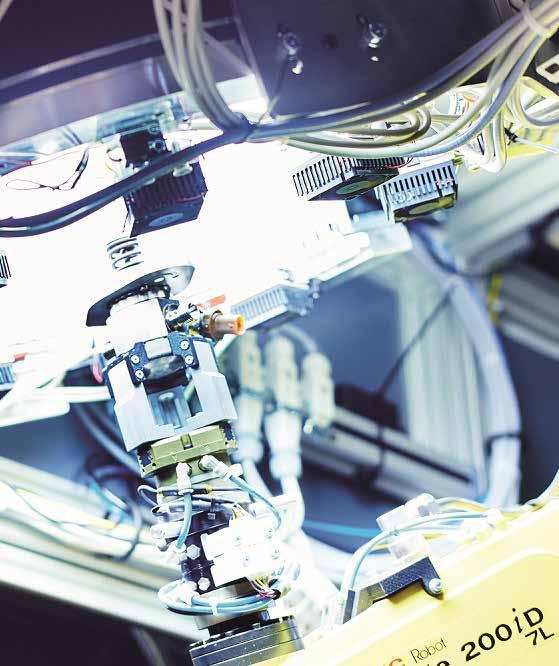
4 minute read
CONNECTIVITY
FUTURE IN CONNECTIVITY
Bosch sees factories’ future in connectivity as industry 4.0 shows productivity level at sites has increased by 25 percent
Advertisement
Crises reveal weaknesses. The coronavirus pandemic has highlighted the value of connected manufacturing and logistics. The internet of things (IoT) helps manufacturing companies react more flexibly than before to disruptions, since the utilization and condition of each machine can be tracked in real-time, and there is transparency along the supply chain. “Especially in exceptional times such as the current crisis, connectivity makes companies less vulnerable and helps them keep an even keel,” says Rolf Najork, a member of the Bosch board of management responsible for industrial technology. For example, where the risk of infection makes physical proximity a challenge, shift handovers can be handled digitally. Digitalization enables remote monitoring and maintenance of systems and machines, with no need for a technician on site. Intelligent software can track goods and deliveries, and ensure replenishment, from any location. All this is possible, thanks to Industry 4.0. Connected solutions will help make manufacturing and logistics simpler, more efficient, flexible, and more robust. Bosch is an IoT pioneer. The company began adding connectivity to production and logistics in 2012 – both in its own plants and in those of its customers.
INDUSTRY 4.0 BOOSTS FACTORY PRODUCTIVITY
In the factory of the future, the only static and fixed things are the floors, walls, and ceilings. The factory of the future continually reinvents itself as needed. It is guided by a vision of a manufacturing set-up that can produce thousands of different products and variants, down to a batch size without the need for expensive retrofitting. This is why Bosch is committed to connectivity. Projects in this area drive progress and deliver measurable benefits. With the help of Industry 4.0, it is possible to increase productivity at individual locations by up to 25 percent.
“Connectivity is essential for any company that wants to stay competitive. Industry 4.0 is a historic opportunity, offering enormous potential,” Najork says. “We are not only improving factory productivity, but also enabling companies to respond quickly and appropriately to changes.” To take the example of Bosch, the transition of the automotive industry means pressure on costs for its powertrain division and pressure to adapt. For precisely this reason, the division will be investing some 500 million euros in comprehensively digitalizing and adding connectivity to its manufacturing operations over the next few years. The expected saving will be twice as high: roughly 1 billion euros by 2025. And the use of artificial intelligence is expected to add even more of a boost. The focus here is on AI-based solutions for predictive maintenance of machinery, for quality assurance, and for improving production processes. For example, AI is used in highly complex wafer fabs – such as the Bosch plant in Reutlingen – for detailed production scheduling, saving time and costs as it guides the wafers through more than 500 processing steps. This alone means a 5 percent faster wafer throughput, with an investment payback time of just three months.
FROM INDIVIDUAL PROJECTS TO LARGE-SCALE IMPLEMENTATION
In Germany, six out of ten industrial companies with more than 100 employees already use Industry 4.0 applications, according to a recent study by the industry association Bitkom. In many cases, however, the applications are only piecemeal. The VDMA, the association of German machinery and equipment manufacturers, estimates that 80 percent of the country’s existing machinery has yet to be digi-

talized. “There’s still a lot more we can do in manufacturing, and many points we can tweak and adjust. Our task now is to make Industry 4.0 the norm in all parts of the manufacturing sector,” Najork says. For companies, the biggest obstacle to implementing Industry 4.0 is the large sums of capital this requires (Bitkom, 2020). In fact, machinery can also be retrofitted with communications technology and sensor systems. Doing so opens the door to the industrial internet of things. The Bosch Rexroth plant in Erbach, Germany, shows how even minor investments in large-scale machine lines can pay off: It spent 25,000 euros on equipping these lines with sensors and light barriers saves some 200,000 euros a year.
BALANCING ECONOMIC AND ECOLOGICAL FACTORS THROUGH CONNECTED SOLUTIONS
As a leading IoT company, Bosch has all the core competencies required to shape Industry 4.0. Its portfolio includes software packages for

maintenance, monitoring, and logistics, robotics systems for manufacturing and transport, retrofit solutions for existing machinery, and assistance systems for machine operators. Now Bosch is debuting a software-based, 5G-capable control technology that is open to thirdparty applications. ctrlX Automation marks an end to isolated solutions in factories.
Featuring more than 30 data protocols, the new Bosch Rexroth automation platform will be the control center of the factory of the future. With its improved Nexeed Industrial Application System, Bosch Connected Industry offers more than merely an “app store” for manufacturing and logistics. The various software applications can be ordered, used, and combined as needed. All machine data is available in a transparent and standardized format, thus ensuring greater transparency and efficiency. A prime example of how to harmonize economic and ecological considerations is the Bosch Energy Platform. Once a machine has been connected to it, its power consumption can be tracked, analyzed, and controlled. The result is that more economical factories, require less energy, and emit less CO2, connectivity will play a significant role in making manufacturing climate neutral.






